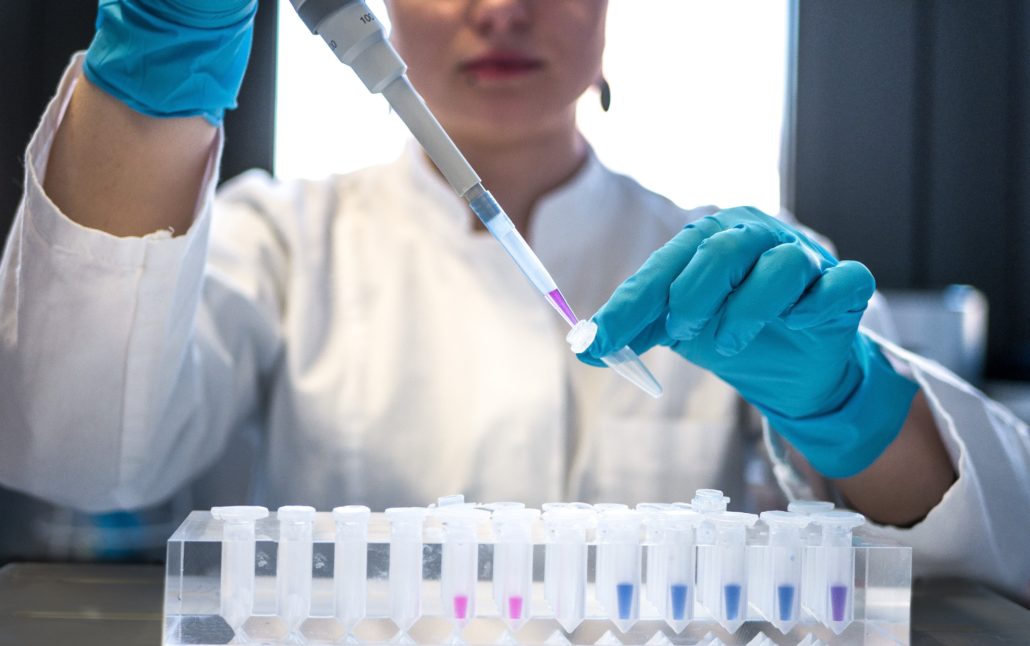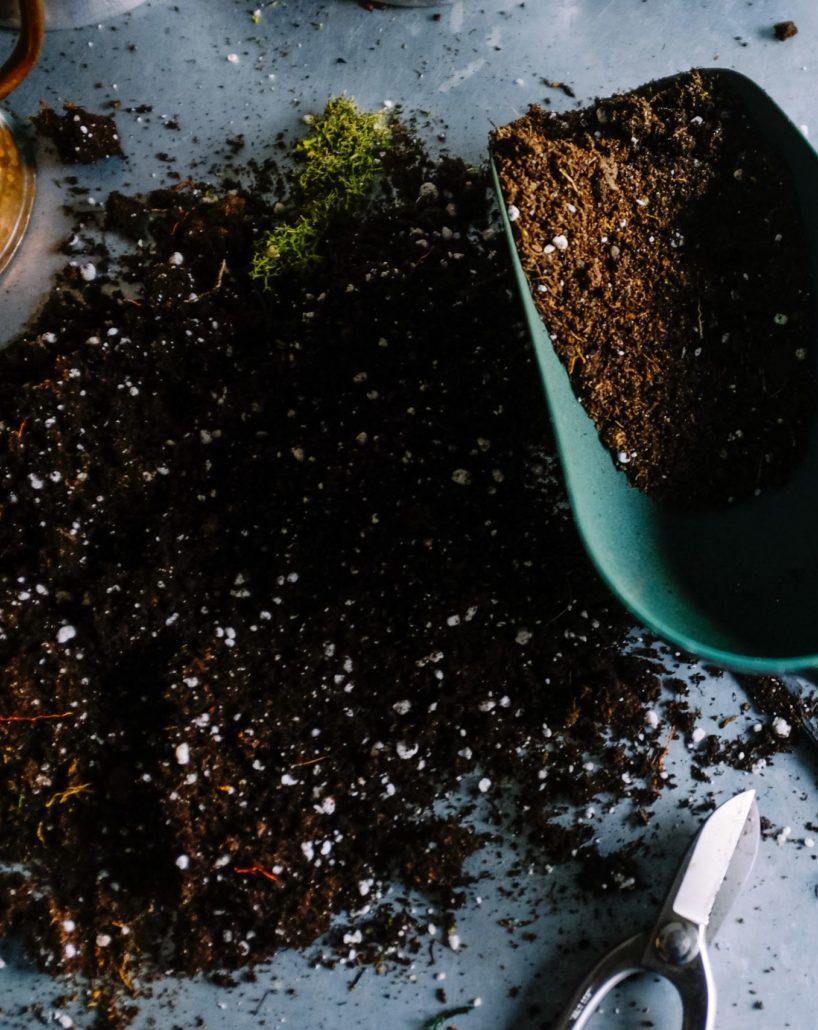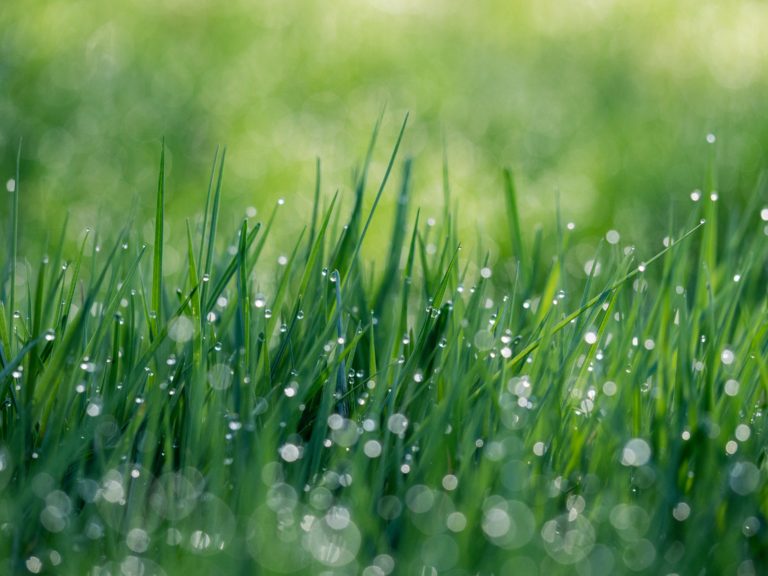Natural lawn care: commonly used chemicals & natural options

When considering all sources of toxicity there is one that is easy to overlook.. your own front yard!
Lawns, parks, golf courses are all places where the lusciousness of the grass may be due to the use of of products like fertiiser which can be detrimental to human health.
In the spring and summer months, those of us who have lawns, enjoy time in the park, or like a nice round of golf are typically in awe of how lush the grass and landscaping can be. This lusciousness can come with a price. In most cases pesticides, insecticides, herbicides, and fertilisers are used. The more conventional products are full of chemicals that can be detrimental to human health. Whether you use these agents or don’t, the airborne nature of these chemicals means they get swept up by the wind and can travel for miles affecting those whom it comes into contact with.
Non-toxic options
The good news about lawn and landscaping maintenance is that there are non-toxic options. This post will discuss the dangers of common toxins used that can contaminate lawn care products and some natural options you can consider. This guide hopes to encourage natural lawn care practices for not only the health of your lawn but for the health of you and your family.


Testing how much exposure you’ve had
More good news is that through FxMed you can access the GPL-TOX test by Great Plains Laboratory. This is a comprehensive non-metal chemical toxin urine profile which will help you understand your exposure levels to commonly encountered chemicals and how much of an effect they may be having on your health.
Below are a few toxins that are tested for which are also common in lawn care.
Perchlorate
This chemical is one of the most common seen populated on the GPL-TOX profile. Due to its use in bleach, fireworks, and in fertilisers it easily becomes contaminated; perchlorate is an easy chemical to become exposed to. Second to bleach, fertilisers are a common source of exposure to perchlorate. This may be surprising since fertilisers do not usually say: this product contains perchlorate. That is because fertilisers are typically contaminated with this chemical. Research shows that perchlorate is water soluble and flows with water. In fertiliser it is positively correlated with the sodium nitrate concentration and negatively with chloride concentration. Ores mined for sodium nitrate used in fertiliser have a higher risk of having perchlorate contamination.
So why is this chemical so important to human health? Acute symptoms of toxicity include: nausea, vomiting, diarrhea, and eye irritation.
It is a thyroid disruptor in elevated, chronic levels. The mechanism at which this happens is at the Na/I- symporter of the basolateral membrane of the thyroid gland. Perchlorate disrupts the transport of iodine into the thyroid which limits thyroid hormone production. This fact is so well known that high doses of perchlorate used to be used as a treatment for hyperthyroidism in the 1950s. Its use was eventually discontinued due to a high number of aplastic anemia cases post treatment.
Long term consistent, regular exposure or an extremely large exposure in a compromised individual is needed for this chemical to cause substantial disruption. So, with application of contaminated fertilisers around your home or workplace this would open you up to a consistent exposure rate. Also due to its contamination nature, water supply should be evaluated if you find this toxin populate on your results.
Organophosphates
The next group of chemicals are commonly used as pesticides known as organophosphates. Whether it be a large landscaping company or your next-door neighbor that loves to garden, organophosphates are regularly used pesticides. What makes them so effective? The way that they work is by inhibiting acetylcholinesterase. This enzyme is required for the degradation of the neurotransmitter acetylcholine into acetic acid and choline. If acetylcholine is allowed to circulate without inhibition, dysfunction sets in as neuronal transmission is allowed to continue unregulated at the muscarinic, nicotinic, and CNS receptors. This leads to death of microorganisms, which makes these chemicals a great pesticide option. Since they are so effective many lawn treatment products may use these as an active ingredient. There are many different chemicals that fall under this category so please refer to your GPL-TOX result for an exhaustive list of examples of what to look for in your products.
In humans, acetylcholinesterase inhibitors are common drugs like donepezil and rivastigmine. These types of drugs are used to treat things like myasthenia gravis, Lewy body dementia, Parkinson’s, glaucoma, and schizophrenia. When exposed to too many, like in organophosphate exposure, symptoms can arise. The prolonged enzyme inactivation leads to acetylcholine accumulation, hyperstimulation of nicotinic and muscarinic receptors, and disrupted neurotransmission, this is what leads to symptomatology. The most common symptomology includes: acute headaches, dizziness, weakness, diarrhea, nausea, vomiting, salivation, watery eyes, and small pupils.
Severe symptoms includes: seizures, slow pulse, difficulty breathing, and coma.
Due to the neuromodulation disruption long term neurologic symptoms can occur, most commonly is peripheral neuropathy. Other symptoms include: agitation, muscle weakness, muscle fasciculations, miosis, hypersalivation, sweating.
Workers that apply these chemicals have high rates of exposure. Symptoms reported in these workers included: impaired memory and concentration, disorientation, severe depressions, irritability, confusion, headache, speech difficulties, delayed reaction times, nightmares, sleepwalking and drowsiness or insomnia, and prolonged psychiatric illness.
Avoidance and detoxification can reduce symptoms.
2,4-Dinitrophenylhydrazine (2,4-DNPH)
This pesticide is a common lawn care agent and many commercial products use this herbicide in their formulas. What makes this herbicide so effective in lawn care is its mechanism of action. It is a synthetic analog of a plant growth hormone called auxin. Auxin is not found in grasses so only weeds are affected. The synthetic auxin causes increased, prolonged growth that eventually speeds up the lifespan and leads to death. It is widely used because it does not affect the grass. This agent is used in many arenas like agriculture, landscaping and privately.
The dangers of exposure to 2,4 D are well known and has been associated with the development of neuritis, nausea, abdominal pain, headache, dizziness, seizures, brain damage, and endocrine disruption.
Glyphosate
The last toxin discussed here commonly used in lawn care is glyphosate. This herbicide is not available on the GPL-TOX profile, but it has its own test that you can consider when toxin testing.
Its use is most common in agriculture, but also by private users. In agriculture, crops that are treated most often with glyphosate are soybeans, corn, cotton, wheat, alfalfa, sorghum, sugar beets, canola, oranges, barley, and several other crops. There is also private use of this chemical. Most individuals would recognize it as Roundup. Just this summer I can remember seeing at least 3 neighbours throughout my neighborhood using Roundup to kill the weeds in their driveway or yard. It’s still very commonly used in residential areas.
Glyphosate is touted as an effective herbicide due to its mechanism of action. The shikimate pathway is the biochemical pathway in which this agent acts. In some organisms it acts to block amino acid synthesis by inhibiting the binding of phosphoenolpyruvate (PEP) to the enzyme 5-enolpyruvylshikimate-3-phosphate synthase (EPSPS). This is the rate limiting step of the shikimate pathway in the production of aromatic amino acids: tryptophan, tyrosine, and phenylalanine. It also blocks the conversion of shikimate to chorismate, a common denominator in the production of many metabolites needed for microorganism life and virulence. Some of these metabolites include vitamins, enterobactin, and needed aromatic amino acids. By inhibiting chorismate’s formation or conversion to these metabolites, pests can be easily killed, and it opens up for research for the production of many antimicrobial agents at the chorismate junctions.
The concern with glyphosate use is its effect on human health. Glyphosate is a known detrimental effect on renal function, chelates to metals like copper and iron, needed for human life, and interferes with CYP 450 enzymes. This herbicide also has the capability to disrupt folate synthesis from probiotics like Lactobacillus and Bifidobacterium, leading to folate deficiency and subsequent sequelae. Our good gut bacteria also have the shikimate pathway and are affected by glyphosate. This allows for the growth of opportunistic bacteria like Clostridia. Also, when they are damaged there are less available amino acids and minerals for our bodily function. One mineral decreased by glyphosate is manganese. A lack of manganese is related to mitochondrial dysfunction and neurotoxicity seen in Parkison’s, Alzheimer’s, and autism. It has also been linked to non-Hodgkins lymphoma and renal tumors.
Natural lawn care options
What options do we as consumers have to reduce our usage of chemicals on our personal lawns? The good news is that anyone can switch to or start their lawn on a natural lawn care regime. The benefit of switching to a natural option is that for your health and that of your family by reducing your exposure to commonly used chemicals. Additionally these options will help you better understand your lawn and it’s needs.
Fertilisers are often used to support the growth of your grass and are a big part of caring for your lawn naturally. Natural fertilisers come in both dry and liquid varieties. Dry fertilisers are usually more affordable in bulk and best applied before the planting season, so great for gardeners. While liquids are best for the start of the season and mid-season and ease of application. These fertilisers are created with adequate nitrogen, phosphorus, and potassium (NPK) for lawn health. Most of these are commercially available in store or online. Types of fertilizer ingredients include the following:
- Animal-based: fish emulsions, blood emulsions, fish meal, shellfish, and animal manure
- Plant-based: alfalfa and soybean meal, compost, cottonseed meal, molasses, legume crop cover, green manure, kelp seaweed
- Mineral-based: calcium, epsom salt, greensand- a mineral blend from the ocean floor
- DIY: involve the combination of soda, soap, ammonia, beer, and mouthwash
- Composting
More info on how to do this can be found easily online
Each type has its own ratio of NPK that should be assessed for your lawn’s specific needs


In addition to choosing the correct fertiliser, knowing practices of lawn care can help your lawn flourish. Some tips to add to your lawn care habits via Beyond Pesticides are:
- Mow high: by mowing too low you invite sunlight to the lower growing weeds. This allows for increased growth. By keeping your grass at 7.6cm- 8.9cm during the mowing season weed growth can be limited
- Aerate your lawn: aeration allows for free flow of nutrients from the soil to the lawn. If the soil is too compacted for proper growth and can promote weeds.
- Fertilise: adding the right fertilizer and leaving clippings on the lawn you will encourage grass growth and suppress weeds. Also consider compost as a source for your fertiliser.
- Over seed: in the fall seeding your grass will ensure growth for your lawn. Be sure to speak with your local nursery to learn the best seed for your area.
A word of caution to using natural agents. Some of the agents may be harmful to pets. Some of the ingredients when ingested in large quantities can lead to GI symptoms, pancreatitis, and foreign body obstruction. These are usually seen from the direct ingestion from the bag rather than the ingestion from the lawn. Be sure to keep these agents in a secure place and keep a close eye on pets after initial applications.
By switching to natural lawn care options, we can reduce the number of pesticides in our lives and the lives of others. This reduction will lead to less health complications, as described above.
Please view the reference section below for deeper reading into the info on various natural lawn care options.

- 2,4-d. National Pesticide Information Center. (n.d.).
- Amrhein, N., Deus, B., Gehrke, P., & Steinrücken, H. C. (1980, November 1). Site of the inhibition of the SHIKIMATE pathway By Glyphosate: II. interference of Glyphosate With CHORISMATE formation in vivo and in VITRO 1. OUP Academic.
- Bai, S. H., & Ogbourne, S. M. (2016, August 19). Glyphosate: Environmental contamination, toxicity and potential risks to human health via food contamination. Environmental Science and Pollution Research.
- Centers for Disease Control and Prevention. (n.d.). Fallon Nevada: FAQS: Organophosphates. Centers for Disease Control and Prevention.
- Colović, M. B., Krstić, D. Z., Lazarević-Pašti, T. D., Bondžić, A. M., & Vasić, V. M. (2013, May). Acetylcholinesterase inhibitors: Pharmacology and toxicology. Current neuropharmacology.
- Costa, L. G., & Aschner, M. (2014, November 28). Toxicology of pesticides. Reference Module in Biomedical Sciences.
- Dakhakhni, T. H., Raouf, G. A., & Qusti, S. Y. (2016, May). Evaluation of the toxic effect of the Herbicide 2, 4-D on rat HEPATOCYTES: An FT-IR spectroscopic study. European biophysics journal : EBJ.
- Environmental Protection Agency. (n.d.). 2,4-D. EPA.
- Fertilizer and Mulch dangers for dogs. Pet Health Network. (n.d.).
- Flores, R., Johansson, R., Bloomfield, F., & Sky, Z. (2019, February 15). Perchlorate – toxicity, side effects, diseases and environmental impacts. Natural Pedia Com.
- Glyphosate clinical references. The Great Plains Laboratory, Inc. (n.d.). SOURCE.
- He, Z. (n.d.). Chorismate Metabolism. Chorismate.
- History.com Editors. (2011, August 2). Agent orange. History.com. SOURCE.
- Holländer, H., & Amrhein, N. (1980, November 1). Site of the inhibition of the SHIKIMATE pathway By Glyphosate: I. inhibition By Glyphosate of PHENYLPROPANOID synthesis IN buckwheat (FAGOPYRUM ESCULENTUM MOENCH) 1, 2. OUP Academic. SOURCE.
- J, W. (n.d.). Perchlorate and the thyroid gland. Pharmacological reviews.
- Jaga, K., & Dharmani, C. (2003, September 1). Sources of exposure to and public health implications of organophosphate pesticides. Revista Panamericana de Salud Pública.
- Jim Isleib, M. S. U. E. (2021, July 29). Pros and cons of granular and liquid fertilizers. MSU Extension.
- Lawn care chemicals: How toxic are they? Eartheasy Guides & Articles. (n.d.).
- Lawns and landscapes. Beyond Pesticides. (n.d.).
- Leung, A. M., Pearce, E. N., & Braverman, L. E. (2010, February). Perchlorate, iodine and the thyroid. Best practice & research. Clinical endocrinology & metabolism.
- LM;, H. K. M. W. (n.d.). THE SHIKIMATE PATHWAY. Annual review of plant physiology and plant molecular biology.
- Moghe, A., Ghare, S., Lamoreau, B., Mohammad, M., Barve, S., McClain, C., & Joshi-Barve, S. (2015, February). Molecular mechanisms of acrolein toxicity: Relevance to human disease. Toxicological sciences : an official journal of the Society of Toxicology.
- Organic lawn fertilizer. Sodlawn. (2021, January 30).
- Perchlorate poisoning. Environmental Pollution Centers. (n.d.).
- RobinMesnage, & N.Antoniou, M. (2020, April 22). Computational modelling provides insight into the effects of glyphosate on the shikimate pathway in the human gut microbiome. Current Research in Toxicology.
- Samsel, A., & Seneff, S. (2013, December). Glyphosate, pathways to modern DISEASES II: Celiac Sprue and gluten intolerance. Interdisciplinary toxicology.
- Samsel, A., & Seneff, S. (2015, March 24). Glyphosate, pathways to modern diseases iii: Manganese, neurological diseases, and associated pathologies. Surgical Neurology International.
- Sears, M., Walker, C. R., van der Jagt, R. H., & Claman, P. (2006, April). Pesticide assessment: Protecting public health on the home turf. Paediatrics & child health.
- Singh, B. K., & Shaner, D. L. (2017, June 12). Rapid determination of glyphosate injury to plants and identification of glyphosate-resistant plants: Weed technology. Cambridge Core.
- Trang, A. (2021, May 9). Physiology, acetylcholinesterase. StatPearls [Internet].
Share:
Related Posts

Goodbye Pie Chart, Hello Phase 1 Sliders
Written by Allison Smith, ND | 2025 As we usher in a new era of DUTCH testing which leaves behind the concept of the three-way

Introducing the DUTCH Dozen
Written by Kelly Ruef, ND | 2025 Hormone testing can be complex, which is why Precision Analytical developed the DUTCH Dozen, an interpretive framework that

DUTCH Report Enhancements
Written by Hilary Miller, ND | 2025 Precision Analytical have released the newest version of the DUTCH Test. This is the report’s most significant update

Gallbladder Health 101: What It Does and How to Keep It Working Well
Written by Ashley Palmer & Pooja Mahtani | 2025 The gallbladder may not get much attention compared to the gut, but it plays a central

Can You Bring Vitamins on a Plane? How To Travel with Supplements
Written by Austin Ruff | 2024 Are you traveling for a work conference, an athletic competition, or a weekend getaway? Just because you’re leaving home
